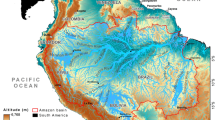Abstract
Local species populations that are more numerically abundant and occupy a greater proportion of the landscape relative to other species often recover more quickly (i.e., are more resilient) following local-scale environmental perturbations. In a companion study, we found that seatrout juvenile populations were distributed more broadly across Tampa Bay, Florida, and numerical abundance was generally much higher than those of similar-sized red drum, suggesting that spotted seatrout may also be generally more resilient to population declines than red drum. Following major population declines over a 12-year period (1996–2008), we found that larger juveniles of seatrout (51–100 mm standard length) simultaneously gained numerical abundance and broadened their spatial distribution generally within the next year. Population recovery in the same size of juvenile red drum generally took multiple years, and distribution and abundance increases were not always concurrent during the recovery period. Despite their overall higher abundance and broader spatial distribution, the smaller-sized juveniles of spotted seatrout (15–50 mm standard length (SL)) did not always recover more quickly from population declines compared with similar-sized red drum. Populations of the smaller-sized juveniles of both species often took multiple years to recover and showed non-concurrent increases in distribution and abundance during recovery. Despite their relatively narrow spatial distribution, juveniles of red drum may increase their overall resilience to local environmental perturbations by occupying multiple isolated patches across the Tampa Bay landscape. Monitoring dynamics of numerical abundance and spatial distribution may be helpful in gauging relative population resilience to facilitate overall management of these fishery populations.


Similar content being viewed by others
References
Bascompte, J., H. Possingham, and J. Roughgarden. 2002. Patchy populations in stochastic environments: critical number of patches for persistence. The American Naturalist 159(2): 128–137.
Brown, J.H. 1984. On the relationship between abundance and distribution of species. The American Naturalist 124(2): 255–279.
Environmental Protection Commission of Hillsborough County. 2000. Final damage assessment and restoration plan and environmental assessment for the December 7, 1997 Alafia River spill. http://www.gc.noaa.gov/gc-rp/muldarp2.pdf
Fisher, J.A.D., and K.T. Frank. 2004. Abundance–distribution relationships and conservation of exploited marine fishes. Marine Ecology Progress Series 279: 201–213.
Fisher, J.A.D., K.T. Frank, and W.C. Leggett. 2010. Dynamic macroecology on ecological time-scales. Global Ecology and Biogeography 19: 1–15.
Flaherty, K.E., and J.H. Landsberg. 2011. Effects of a persistent red tide (Karenia brevis) bloom on community structure and species-specific relative abundance of nekton in a Gulf of Mexico estuary. Estuaries and Coasts 34: 417–439.
Foggo, A., M.T. Frost, and M.J. Attrill. 2003. Abundance-occupancy patterns in British estuarine macroinvertebrates. Marine Ecology Progress Series 265: 297–302.
Gaston, K.J., and J.L. Curnutt. 1998. The dynamics of abundance-range size relationships. Oikos 81: 38–44.
Gaston, K.J., T.M. Blackburn, J.J.D. Greenwood, R.D. Gregory, R.M. Quinn, and J.H. Lawton. 2000. Abundance–occupancy relationships. Journal of Applied Ecology 37(Suppl. 1): 39–59.
Greene, G., C.B. Moss, and T.H. Spreen. 1997. Demand for recreational fishing in Tampa Bay, Florida: A random utility approach. Marine Resource Economics 293–305.
Gunderson, L.H. 2000. Ecological resilience—in theory and application. Annual Review of Ecology and Systematics 31: 425–439.
Hanski, I., A. Moilanen, and M. Gyllenberg. 1996. Minimum viable metapopulation size. American Naturalist 147: 527–541.
Holling, C. 1973. Resilience and stability of ecological systems. Annual Review of Ecology and Systematics 4: 1–23.
Hu, C., F.E. Muller-Karger, and P.W. Swarzenski. 2006. Hurricanes, submarine groundwater discharge, and Florida’s red tides. Geophysical Research Letters 33(L11601): 5.
Johansson, J.O. R. 2002. Historical overview of Tampa Bay water quality and seagrass issues and trends. Reports. Paper 147. http://scholarcommons.usf.edu/basgp_report/147
Lawton, J.H. 1999. Are there general laws in ecology? Oikos 84: 177–192.
Petitgas, P. 1998. Biomass-dependent dynamics of fish spatial distributions characterized by geostatistical aggregation curves. ICES Journal of Marine Science 55: 443–453.
Purvis, A., J.L. Gittleman, G. Cowlishaw, and G.M. Mace. 2000. Predicting extinction risk in declining species. Proceedings of the royal society of London. Series B: Biological Sciences 267(1456): 1947–1952.
Roberts, C.M., C.J. McClean, J.E. Veron, J.P. Hawkins, G.R. Allen, D.E. McAllister, C.G. Mittermeier, et al. 2002. Marine biodiversity hotspots and conservation priorities for tropical reefs. Science 295(5558): 1280–1284.
Walters, S., S. Lowerre-Barbieri, J. Bickford, J. Tustison, and J.H. Landsberg. 2013. Effects of Karenia brevis red tide on the spatial distribution of spawning aggregations of sand seatrout Cynoscion arenarius in Tampa Bay, Florida. Marine Ecology Progress Series 479: 191–202.
Whaley, S.D., M.C. Christman, J.J. Burd Jr. 2015. Spatial distribution-abundance relationships in juvenile (Age-0) red drum (Sciaenops ocellatus) and spotted seatrout (Cynoscion nebulosus). I: Influence of Freshwater Inflow. (This issue).
Williams, S.E., L.P. Shoo, J.L. Isaac, A.A. Hoffmann, and G. Langham. 2008. Towards an integrated framework for assessing the vulnerability of species to climate change. PLoS Biology 6(12): e325.
Acknowledgments
We are grateful to the Florida Fish and Wildlife Research Institute’s Fisheries-Independent Monitoring program for collecting the field data used in this analysis. This sampling program is partially supported by the US Fish and Wildlife Service (Sport Fish Restoration Grant F-43). In addition, we greatly appreciate the support by senior staff (H. Norris, R. Flamm, and K. O’Keife) and the entire Center for Spatial Analysis team at FWRI (partially supported by the US Fish and Wildlife Service, Sport Fish Restoration Grant F-66). This manuscript benefited from valuable comments from W. Cooper, M. Barrett, R. Butryn, C. Harmak, and several anonymous reviewers.
Author information
Authors and Affiliations
Corresponding author
Additional information
Communicated by Josianne G. Støttrup
Rights and permissions
About this article
Cite this article
Whaley, S.D., Christman, M.C. & Burd, J.J. Spatial Distribution-Abundance Relationships in Juvenile (Age-0) Red Drum (Sciaenops Ocellatus) and Spotted Seatrout (Cynoscion Nebulosus). II: Influence of Major Disturbances. Estuaries and Coasts 39, 752–758 (2016). https://doi.org/10.1007/s12237-015-0035-3
Received:
Revised:
Accepted:
Published:
Issue Date:
DOI: https://doi.org/10.1007/s12237-015-0035-3




